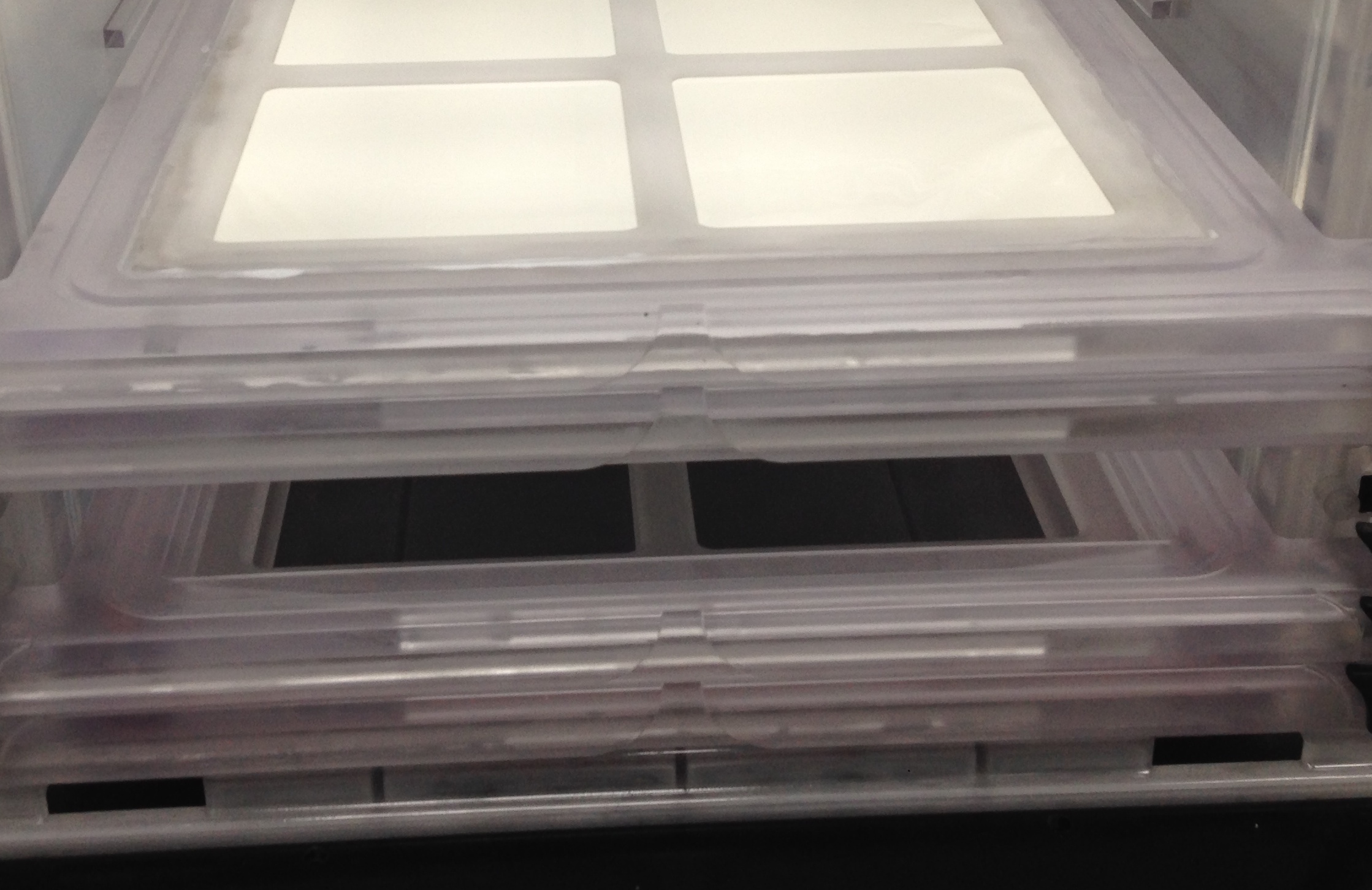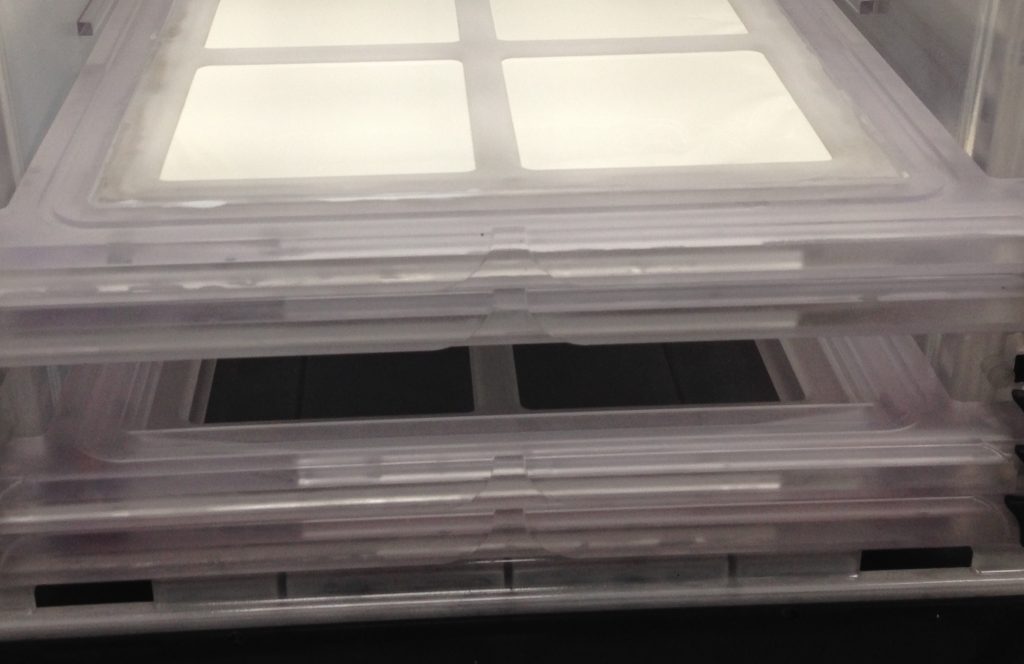- Nano-selective forward osmosis technology by SideStroem featured in Everything About Water - February 10, 2024
- SideStroem and Singapore Institute of Technology featured in AsianScientist - April 29, 2023
- SideStroem joins world class accelerator program - November 12, 2022
Plate & frame modules made from flat sheet forward osmosis membranes
Plate & frame (stacked) FO module summary
| Packing density | typically below 100 m2/m3 |
| Advantage | ease of operation when waste streams contain high amounts of fouling agents and/or solutions entering the module have high viscosities |
| Disadvantage | large footprint increases space requirements – not suitable for high volume applications |
Detailed description
 Plate & frame membrane modules – also known as stacked membrane modules – are used in many water treatment applications where the waste streams to be treated contain high amounts of fouling agents and/or have high viscosities. In fact, many commercial membrane bioreactor (MBR) modules belong to the plate & frame configuration. Plate & frame modules typically consist of flat sheet membranes sealed to frames, which provide the overall mechanical integrity and flow distribution needed to stack individual frames together in a modular way. Thus, individual frames function as membrane cassettes where the waste stream to be treated typically flows outside the cassette with the clean water permeating to the inner volume of the cassette for subsequent collection.
Plate & frame membrane modules – also known as stacked membrane modules – are used in many water treatment applications where the waste streams to be treated contain high amounts of fouling agents and/or have high viscosities. In fact, many commercial membrane bioreactor (MBR) modules belong to the plate & frame configuration. Plate & frame modules typically consist of flat sheet membranes sealed to frames, which provide the overall mechanical integrity and flow distribution needed to stack individual frames together in a modular way. Thus, individual frames function as membrane cassettes where the waste stream to be treated typically flows outside the cassette with the clean water permeating to the inner volume of the cassette for subsequent collection.
Forward osmosis plate & frame modules are – in principle – constructed in a similar manner with the added complexity that the frame/cassette/module designs must accommodate cross flow distribution of feed and draw streams across each individual membrane layer while avoiding direct mixing of said feed and draw streams.
From an engineering point of view, it is difficult to achieve such cross flow distributions, and at the same time avoid unstirred regions, when the distance between individual membrane layers is reduced. As a result, plate and frame forward osmosis membrane modules typically have the lowest packing density / largest footprint of the 4 module design variants considered here (see the table below).
The large footprint of plate & frame forward osmosis membrane modules excludes these modules from being used in high volume applications such as municipal waste water treatment and desalination of seawater. However, in many lower volume applications, where the waste streams to be treated contain high amounts of fouling agents and/or have high viscosities, the low packing density of plate & frame modules represents an operational advantage. The reason being, that a larger distance between membrane sheets results in a lower pressure drop across the module (i.e. lower energy requirement for pumping solutions through the module) as well as a lower propensity towards clogging of flow channels due to accumulation of fouling agents.
| Parameter | Value |
| Area of individual sheets (including sealing) | 0,25m2 |
| Active membrane area per sheet (excluding sealing) | 0,23m2 |
| Thickness of individual membranes | 200μm |
| Distance between membrane sheets | 8mm |
| Number of sheets per module | 43 |
| Internal volume of module | 0,09m3 |
| Active area per module | 9,9m2 |
| Packing density | 110 |
The links below lead to detailed descriptions of other forward osmosis module designs:
- Spiral wound forward osmosis membrane modules
- Tubular forward osmosis membrane modules
- Hollow fiber forward osmosis membrane module


Hi Ed
I am student of BS chemical engineering, final semester. We need FO unit for experimentation purpose. Feed to be treated is produced water from an upstream Oil & Gas company. In my opinion plate & frame configuration should suit the said feed, however you can consider it also.
What I need to know is dimensions, active area and price, also the date of delivery most importantly.
Seeking for your reply.
We initially need 15 module system for feed throughput of 570 BPD.
Hi Mujahid
Thanks for reaching out on your exiting plans. Would it be possible for you to share some additional information with regards to the questions below?
– What is the composition of the feed water to be treated (TDS, COD, BOD, SDI, viscosity, etc)?
– Have you given thought to the draw solution you will be using?
– What exactly do you mean by “15 module system”?
– Can you give me a more detailed breakdown of the feed throughput (i.e. liters/hour) and which recovery rates you are aiming for?
– What is your budget and expected lead time?
– Where is the system to be located and which external conditions will it be facing?
Cheers
Ed
Hi Ed:
Here are the specs, you asked for:
1) Composition: (kindly mention your e-mail, I’ve detailed composition analysis report, I’ll send it to you)
2) At the moment we are thinking to use NaCl sol as draw.
3) 15 module system we meant that our flow rate demands 15 modules of active area(given for plate & frame module), assuming flux of 12L/m2.hr.
4)It is 3900 L/hr. Recovery rate is 50 volume% extraction of water from feed, into draw sol, i.e. 1950 L/hr. But this is for full scale process. On lab scale, we can select a basis(lower than full scale) according to the equipment capacity available with you.
5) Budget is not specified yet, however you share the gross total with us, we will manage that.
6) It is to be located in the Northern area of Pakistan, in an upstream oil field. Weather is mostly dry and severe. Temp range is (8 to 40) deg C generally.
Hope I have given the specs you asked for.
Looking forward to your kind reply.
Hi Mujahid
Apologies for the late reply. Thanks a lot for sending the specifications. I believe they will be helpful for FO membrane suppliers to provide you with the right solution.
You can get in touch with us at forwardosmosistechportal@gmail.com.
Cheers
Ed
Hi Ed, do you supply the FO module without membrane to oversea? Can we use less than the 43 sheets in the module?
Hi Goh Li
Thanks for reaching out on this. I’m afraid we do not provide FO products through the ForwardOsmosisTech Portal – only FO related knowledge.
I think it may be difficult for you to find a FO membrane provider who will deliver their modules without membranes. Afterall, the FO membrane is the core technology in an FO module.
Have you considered buying smaller FO test cells for your experiments?
Cheers
Ed
Dear Goh Li and Mujahid,
At Aquaporin we are developing and manufactoring FO membranes. The advantage of using our FO membranes, is that we have developed a way to integrate natures own aquaporin proteins, into the membrane, hence we have improved the FO membranes ability to reject contaminents. I will be happy to share more informations about our technology and discuss the opportunities it brings. We both have FO flatsheet membrane and FO Hollow Fibers. Please do not hesitate to contact me at cdl@aquaporin.dk.
All the best
Christian
When is the First Plat-and-Frame forward osmosis module ever introduced and if there are any other companies that successfully commercialized it beside Porifera?
furthermore, if this technology ever been considered for Desalination since it produced more water flux than other Spiral wound membrane module.
Thanks goes for Forwardosmosistech.
Hi Motaz,
To my knowledge, industrial sized plate-and-frame forward osmosis modules were only fairly recently introduced on a commercial scale – say within the last 5 years.
I don’t think plate-and-frame modules are suitable for desalination due to their low packing density. I believe this is why Porifera seem to be focusing their commercial efforts on high-value food processing applications.
Cheers
Mark